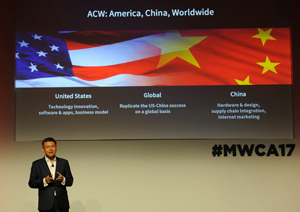Lixin Cheng, CEO of ZTE Mobile Devices and member of CTIA’s board of directors and executive committee, spoke at the U.S.-China Summit during Mobile World Congress Americas (MWCA) 2017.
Cheng shared ZTE’s experience working on 5G in the U.S. and China and provided his view of the future of collaboration through innovation, expected to benefit not only China and the U.S., but the world.
U.S. and China, Leading World’s Innovation, Benefit from Collaboration
Investing billions to expand telecommunications each year, the U.S. and China share similar ideas for the next generation of the Internet and innovative strategies.
In 2016, China spent $50 billion in the U.S. for technology investments. In the reverse direction, the U.S. invested $92 billion in China.
China has 1.32 billion mobile phone users, with $53 billion in telecom capital expenditures each year; $34 billion is expected to be spent on 5G in 2020. In comparison, the U.S. has 327 million mobile phone users, spends $73 billion each year on telecom capital and is expected to spend $45 billion on 5G in 2020.
China has 771 million internet users, of which 695 million are mobile users. By comparison, the U.S. has 286 million internet users, including 225 million mobile users.
Cheng believes this huge consumer demand for telecommunication and internet services in both countries requires further collaboration between both countries.
ZTE Growing From Domestic to International
ZTE's accumulated R&D investment is approximately $15 billion, with the total R&D in the first half of 2017 about $1 billion (12.4 percent of revenue).
In China, ZTE is the leading LTE vendor, holding more than one-third of the 4G network market. ZTE also accounted for one-third of the global shipments of TDD-LTE eNB. ZTE's LTE EPC has been deployed in more than 90 percent of the provinces in China.
ZTE is the first to successfully launch massive MIMO commercial products, with more than 3,000 experts engaged in 5G R&D. It is pioneering sustainable Pre-5G commercialization and has deployed more than 60 Pre-5G networks in over 40 countries.
In the phase II eMBB tests conducted as part of China’s 5G program, the peak throughput of ZTE’s 5G 3.5 GHz cell exceeded 19 Gbps; at the high frequency band (26 GHz), single user equipment throughput exceeded 13 Gbps.
ZTE is working closely with governments and associations in the U.S. and China for 5G, since both countries are leading for the next generation of wireless. As the only Chinese council member of CTIA, the top wireless association in the U.S., ZTE is helping to drive the standardization of spectrum and network technology for 5G.
ZTE has nearly 81,000 employees globally, including 30,000 specialists in R&D, 107 global affiliates, six regional customer support centers and 46 local customer support centers.
From 2010 to 2016, ZTE was the only Chinese company on the PCT patent application list that ranked in the top third for seven consecutive years — including number one three times.
ZTE Growing in the U.S. Market
In the U.S., ZTE spends $2.6 billion per year purchasing products and technologies from U.S. companies. It is now the fourth biggest vendor with a market share of 12.2 percent, maintaining long-term cooperation with all major carriers and 33 million active users in the U.S.
ZTE is building a base of support in the U.S. by hiring locally — 80 percent of the employees hired in the U.S. are local.

